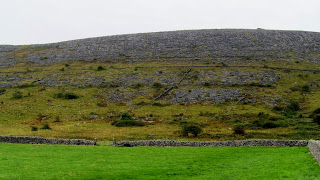September 17, 2013
After breakfast in the Galway city centre, we again headed
south with our first stop being Dunguaire Castle in Kinvara, County Galway. The castle was built in 1520 and was last
used as a home in 1968. Although it is
called a “castle”, it is in reality a “tower house” typical of that era . Tower houses were fortified residences built
as a “fashionable” Irish house for a gentleman or wealthy farmer between 1450
and 1650 A.D. Dunguaire is a four-story
structure and the owners have done a nice job of furnishing it in “period”
furnishings. Mediaeval dinners and other
events are held there on occasion but we opted to skip tonight’s dinner and
continued on our way.
Dunguaire Castle (ca. 1520)
Looking at the landscape around the castle
Thatched roof cottages near the castle
Further south, we drove through part of an area known as The
Burren in County Clare, a portion of which has been designated a national
park. This is a very large plateau
composed of barren limestone rock in unique striated patterns that used to be
below sea level in ancient times. The
land was later thrust upward by some kind of massive geological event. This was fascinating scenery unlike any I have
seen before.
The Burren
Our next stop were the Cliffs of Moher, said to be Ireland’s
most-visited natural attraction. The
cliffs are vertical limestone cliffs that plunge 500 to 700+ feet into the
sea. Although conditions were not the best
today, the cliffs were spectacular! It
is understandable why the area has been used as a setting for movies and TV
shows. The wind was blowing very hard
here—I estimated the gusts at 50-60 mph.
It was very hard to walk upright and Richard was even blown over by one gust!
The Cliffs of Moher

Richard and Essie at the Cliffs of Moher
We continued our drive on down to the Dingle Peninsula,
County Kerry, in southwestern Ireland where we stayed the night. The landscape changed as we came south with
larger fields and fewer rock walls and trimmed hedges around the fields. More farming was in evidence and there were
more trees. Houses were also evolving
into fewer of the tall, box-style, homes of the north country into more homes
similar to those we see in the States.
We did not see as many sheep today as further north; however, we did see
more dairy herds.
Driving along a couple of country roads--and, yes, the speed limit is 50 mph!
I asked our hostess if this cold, wet, windy weather is
normal for September. She said it was
not normal, that this is winter weather we are experiencing! She went on to say the only difference
between this week’s weather and the real winter weather is that it can get even
windier with storms during the winter months.
FAST FACTS: Ireland
regularly leads the world in binge drinking.
Although efforts are being made to educate the populace, especially
young folks, about the devastation caused by excessive alcohol use, drinking
remains the country’s most popular social pastime with no signs of letting up.
Urbanization is breaking down traditional family/community
interdependence that was prevalent during times of poverty in the country. These traditional values can still be found
in isolated rural communities and on islands.
The average number of children per family has fallen to 1.4, the lowest
in Irish history.












